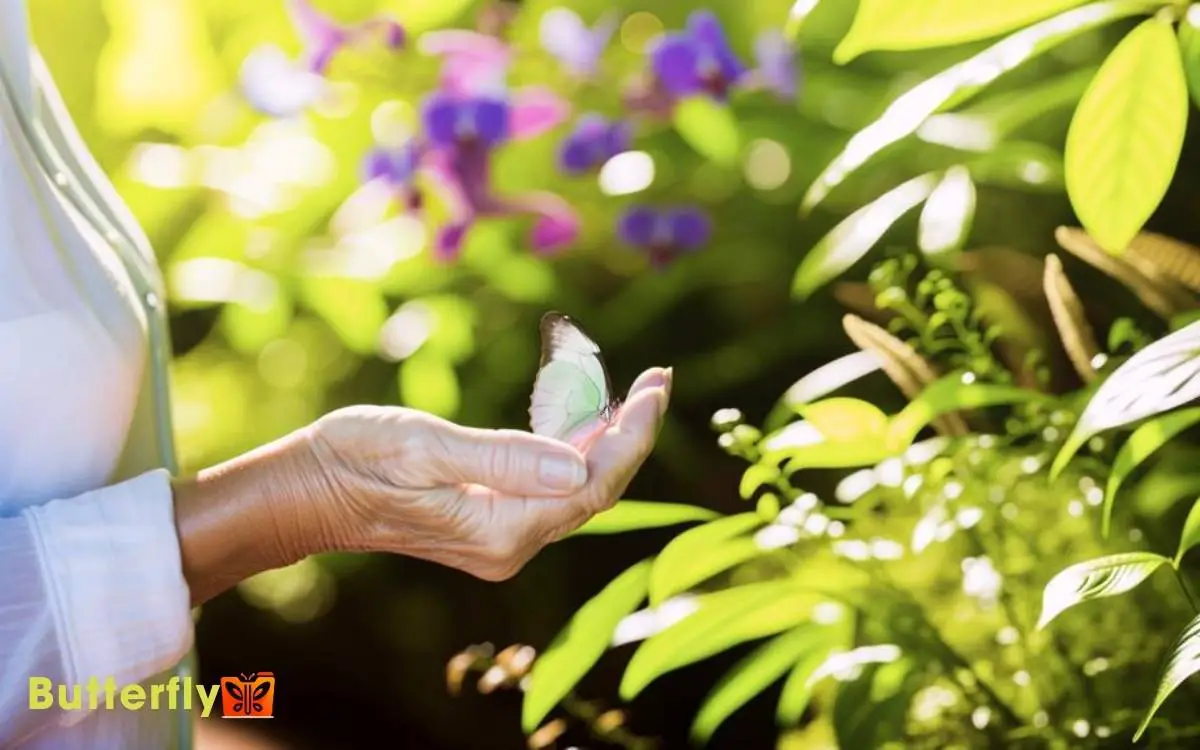How Do You Fix a Butterfly’s Wing? Step-by-Step Process!
To fix a butterfly’s wing, first, identify the damage by examining for tears, breaks, or missing sections. Gather supplies like a magnifying glass, fine-tipped tweezers, non-toxic adhesive, precision scissors, and lightweight paper for patches.
Create a soft-lined container to gently place the butterfly in a calm environment. Carefully align the wings using forceps and apply adhesive without touching the scales. Allow for recovery in a ventilated container with proper temperature and diet.
Finally, release the butterfly on a sunny day. By following these steps, you’ll give the butterfly a chance to thrive again in its natural habitat. For complete guidance, continue below.

Key Takeaways
Identifying Wing Damage
When identifying wing damage in butterflies, closely examine the wing’s surface for tears, missing sections, or abnormal deformations. You’ll want to gently handle the butterfly, ensuring minimal stress.
Look for breaks along the wing veins, which are important for structural integrity. Notice if any scales are missing these tiny, overlapping structures provide the wing’s coloration and protection. Wing edges should be smooth; jagged or irregular edges often indicate damage.
Pay attention to discolorations or spots, which can signify underlying issues. If the butterfly struggles to fly or maintains an unusual posture, this can also indicate wing damage.
Gathering Necessary Supplies
To effectively repair a butterfly’s wing, you’ll need to gather a few essential supplies.
- First, obtain a magnifying glass to closely examine the wing’s intricate structures.
- Next, collect tweezers with fine tips for delicate handling.
- You’ll also need non-toxic adhesive designed for entomological use; this guarantees the butterfly’s safety.
- Scissors with precision blades will help trim any irregular edges.
- Transparent, lightweight paper or a similar material can be used to create a supportive patch.
- Additionally, have a small, clean surface to work on, like a piece of white paper, to prevent contamination.
- Finally, make sure you have a gentle, secure container to temporarily house the butterfly during the procedure.
These supplies will facilitate a meticulous and compassionate repair process.
Preparing the Butterfly
With your supplies ready, gently place the butterfly in a secure, calm environment to minimize its stress before you begin the wing repair. Use a shallow box or container lined with a soft cloth to prevent further injury.
Maintain a gentle touch, as butterflies are delicate and can become easily stressed. Make sure the temperature is stable and the area is free from excessive noise or movement.
| Step | Description |
|---|---|
| Secure Area | Use a soft-lined container to create a safe space. |
| Gentle Handling | Carefully transfer the butterfly to avoid stress. |
| Stable Environment | Keep the area quiet and at a consistent temperature. |
Aligning the Wings
Once the butterfly is settled, carefully align the damaged wing with the healthy one to guarantee proper symmetry and function.
Gently hold the butterfly by its thorax, ensuring minimal stress. Use fine-tipped forceps to grasp the edges of the damaged wing.
Align the torn edges with the corresponding parts of the healthy wing, focusing on matching the veins and patterns for accurate reconstruction.
Ensure both wings are parallel, maintaining natural posture. Precision is vital; improper alignment can hinder flight and compromise the butterfly’s survival.
Take your time, and adjust as needed to achieve perfect symmetry. Your gentle, precise alignment will set the foundation for a successful repair, enabling the butterfly to regain its natural grace and mobility.
Applying the Repair
You’ll want to handle the butterfly’s wings with the utmost care, ensuring minimal stress to the fragile structure.
Utilize precise adhesive application techniques to secure the wing segments effectively.
Gentle Wing Handling
Gently grasp the butterfly’s wing between your thumb and forefinger to prevent any further damage while you prepare to apply the repair. Ensure your grip is vital yet delicate to avoid crushing the fragile wing structure.
Position the butterfly on a flat, stable surface to minimize movement. Utilize a magnifying glass to closely inspect the wing’s damage, identifying tears or missing segments.
Maintain a calm environment to reduce stress on the butterfly. If necessary, use soft tweezers to adjust the wing’s position carefully. Avoid sudden movements or loud noises, as these can startle the butterfly and make the process more difficult. If you’re unsure how to proceed, research proper techniques or consult a specialist for guidance. For additional assistance, you can also look up resources on how to recline Bugaboo Butterfly, as some methods for handling delicate structures may apply.
Avoid direct contact with the wing scales, as these are essential for flight and thermoregulation. Gradually align the edges of the tear to facilitate a seamless repair. Your gentle handling is essential for the butterfly’s recovery.
Adhesive Application Techniques
Carefully apply a small amount of non-toxic adhesive to the edges of the tear, ensuring it’s evenly distributed for a secure and effective bond. Use a fine brush or toothpick to control the application precisely.
Avoid excess adhesive, as it can weigh down the wing and hinder the butterfly’s flight. Hold the wing steady until the adhesive sets usually a few minutes. Ensure the environment is calm to minimize stress on the butterfly.
After the adhesive has dried, gently test the wing’s mobility to confirm the repair’s success. Remember, the goal is to restore functionality without causing additional harm.
Your meticulous attention to detail can greatly impact the butterfly’s ability to fly and thrive again.
Allowing Time for Recovery
Once you have repaired the wing, you must make sure the butterfly has ample time to recover in a safe, controlled environment. Carefully monitor its progress, observing natural healing processes and making any necessary adjustments.
Providing a stress-free habitat will greatly enhance the butterfly’s chances of a full recovery.
Rest and Safe Environment
Creating a secure and tranquil environment is vital for guaranteeing the butterfly has the necessary conditions to heal and regain its strength. Place the butterfly in a small, ventilated container lined with soft materials.
Guarantee the container is kept in a quiet, dimly lit area, free from disturbances and predators. Maintain a stable temperature around 70-75°F (21-24°C), as fluctuations can stress the butterfly.
Provide fresh nectar or a sugar-water solution to support its dietary needs. Avoid handling the butterfly unnecessarily; excessive movement can hinder the healing process.
Monitor humidity levels to prevent dehydration, ideally around 50-70%. By creating a controlled, stress-free setting, you’ll foster prime recovery conditions for the injured butterfly.
Monitoring Natural Healing
Monitoring the butterfly’s progress involves regularly checking for signs of healing and ensuring its environment remains conducive to recovery.
You’ll want to observe the wing’s stability, noting any changes in alignment or tears. Examine the butterfly’s flight behavior; limited, controlled attempts at flying indicate gradual improvement.
Keep the habitat clean and stress-free, as external stressors can impede healing. Guarantee the availability of fresh nectar and hydration sources to maintain its strength.
Temperature and humidity should mimic natural conditions to promote the best possible recovery. Be patient and avoid handling the butterfly excessively.
Document its progress daily for any deviations that might require intervention. By providing a calm and stable environment, you’ll give the butterfly the best chance to heal naturally.
Releasing the Butterfly
Once you’ve confirmed the butterfly’s wing repair is complete and it’s capable of sustained flight, it’s time to release it back into its natural habitat.
Choose a calm, sunny day for release, as butterflies are diurnal and thrive in warm conditions. Gently open the enclosure and let the butterfly acclimate. Avoid direct handling; instead, let it leave on its own.
Make sure the release site has ample nectar sources and shelter, such as flowering plants and shrubs. Monitor the butterfly’s initial flight to make sure it can navigate properly. If it shows signs of distress, you may need to reassess its condition.
Your compassionate efforts have given it a second chance at life—now let nature take its course.
Conclusion
In mending a butterfly’s wing, you’ve not only restored its ability to soar but also contributed to the intricate dance of nature. As you release the butterfly, remember that even the smallest gestures can ripple through the ecosystem.
With expert precision and compassionate care, you’ve turned a fragile moment into a flight of resilience. Your meticulous efforts not only heal a creature but also echo a symphony of life’s delicate balance.






